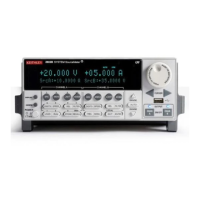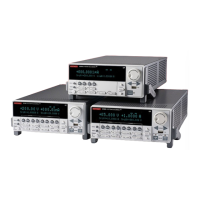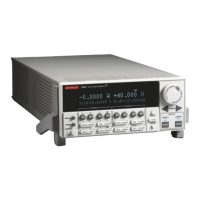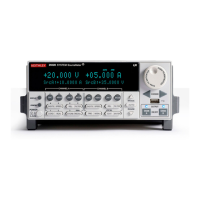19-36 Return to Section Topics 2600AS-901-01 Rev. B / September 2008
Section 19: Remote Commands Series 2600A System SourceMeter® Instruments Reference Manual
digio.trigger[N].wait
Replace N with the number of the digital I/O trigger line: 1 to 14.
Function Waits for a trigger.
TSP-Link
accessibility
This function can be accessed from a remote TSP-Link node.
Usage triggered = digio.trigger[n].wait(timeout)
timeout Specifies the time-out value in seconds.
triggered A customized variable that stores the value true
if a trigger is detected or false if a trigger is not
detected during the time-out period.
n The number of the trigger line.
Remarks • This function waits up to the timeout value in seconds for an input trigger. If one or more trigger
events are detected since the last time digio.trigger[n].wait or
digio.trigger[n].clear was called, this function immediately returns. After waiting for a
trigger with this function, the event detector is automatically reset and rearmed. This is true
regardless of the number of events detected.
Details See Interactive triggering in Section 10.
Also see digio.trigger[N].clear
Example Waits up to three seconds for a trigger to be detected on trigger line 4, then displays if the trigger was
detected:
triggered = digio.trigger[4].wait(3)
print(triggered)
Output:
false A trigger was not detected.
true A trigger was detected.
digio.writebit
Function Sets a digital I/O line high or low.
TSP-Link
accessibility
This function can be accessed from a remote TSP-Link node.
Usage digio.writebit(n, data)
n The digital I/O line number (1 to 14).
data The value to write to the bit; 0 (low) or 1 (high).
Remarks • If the output line is write protected, via the digio.writeprotect attribute, the command will
be ignored.
• The reset function does not affect the present state of the digital I/O lines.
• Use the digio.writebit and digio.writeport commands to control the output state of
the synchronization line when the trigger mode is set to digio.TRIG_BYPASS.
Details See Controlling digital I/O lines in Section 8.
Also see digio.readbit, digio.readport, digio.trigger[N].mode
Example Sets digital I/O line 4 low (0):
digio.writebit(4, 0)
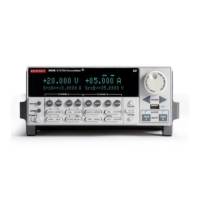
